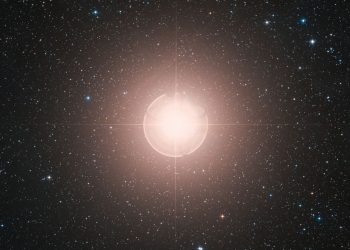Since we became a (semi)intelligent species and began studying the cosmos, humanity has come a long way to realize that we are not the center of the universe, the galaxy, or even the solar system.
Although disappointing for a selfish species, this realization has led us to discoveries about the real nature of our universe, or at least to models that are closer to the truth. Although the idea that the universe is homogeneous and isotropic in all directions has been contested, the assumption that this is the case led us to predictions about the cosmic microwave background (CMB) and the Friedmann-Lemaître-Robertson-Walker (FLRW) metric, which describe an expanding universe, later confirmed by astronomical observations.
“The Copernican principle is the cornerstone of most astronomy, is assumed beyond doubt, and plays an important role in many statistical tests for the viability of cosmological models,” Fermilab’s Albert Stebbins explained to Phys.org in 2008.
“It is also a necessary consequence of the strongest assumption of the cosmological principle: that not only do we not live in any particular part of the universe, but that there are no particular parts of the universe – everything is the same everywhere (up to statistical variation).”
“This is a very practical principle, because it implies that here and now is the same as there and now, and here and then is the same as there and then. We don’t need to look back in time to see how the universe was in our past – we can just look very far away, and given the long travel time of light, we are looking at a distant part of the universe in the distant past. Given the cosmological principle, their past is the same as our past.”
Added to this is the anthropic principle: the idea that conscious observers like us can only exist in a universe that supports life. There may be many universes that do not support life, and we should not be surprised to find ourselves observing in a universe that does support life. Or maybe the universe isn’t the same everywhere. According to some physicists and philosophers, it might be more useful to obtain more useful information by applying Copernican and anthropic principles to time. A smaller subset believe it could be used to impose constraints on the time humanity has left to survive.
The argument was first presented by Australian astrophysicist Brandon Carter, for whom it briefly gained the name the “Carter catastrophe”. The basic idea is that we should not assume that we are in a particular region time as well as space. Over time there will be a finite number of humans, let’s say 1 trillion for simplicity. Statistically, you have to assume that you were born at a random point in human history, not at a particular point like the beginning or the end, which is where most typical observers should be.
“Assuming that everything we measure can only be observed in the interval between tto start and tendsif there is nothing special now, we expect thatNOW fall randomly within this interval. The estimate tfuture = (tEND-tNOW) = tpass = (tNOW-tto start) will overestimate tfuture half the time and I’ll underestimate it half the time,” astrophysicist J. Richard Gott wrote on the subject in 1993.
“If r1 = (tNOW -tto start)/(tEND -tto start) is a random number uniformly distributed between 0 and 1, there is a probability P=0.95 that 0.025
1/39 tonpass future past (95% confidence level)
In the same way,
1/3 tonpass
According to Gott, the length of time something has been observable in the past provides a rough indication of how resilient it is to potential dangers and disasters of the past, but also how likely it is to survive in the future. For this equation to “work” (let’s keep in mind that it is probabilistic and there are many variables that could change it), you simply have to assume that your own position in time is random in this distribution of possible times.
Predicting the end of humanity is not an easy thing to test, unless we leave the conclusion to the robots/hyperintelligent group of mole humans who will inherit the Earth when we are gone. But Gott used this analysis on a less dramatic event, the fall of the Berlin Wall, to demonstrate how it worked. In 1969, Gott visited the Berlin Wall and Stonehenge, which had existed for approximately eight and 3,900 years, respectively.
“Assuming that I am a random observer of the Wall, I expect to be randomly located in time between tto start and tEND (tEND occurs when the wall is destroyed or there are no more visitors to observe it, whichever comes first). The Wall fell 20 years later, giving way tofuture = 2.5 tonnespasswithin the 95% confidence limits predicted by equation (1).”
The same equation predicts that Stonehenge should be observable, which is indeed the case.
“Equation (1) was satisfied not because my visit caused the demise of the USSR, but simply because with hindsight we can now see that the timing of my visit was unremarkable,” adds Gott.
The idea, known as the somewhat dramatic “doomsday argument”, has been used to try to understand where humanity might be on its path to non-existence. Using a toy model and estimates of the number of humans born so far, Gott estimates the total number of humans to be born between 1.8 billion and 2.7 trillion (in 1993), with a 95 percent confidence level.
By looking at birth and death rates, Gott suggests that we may not have much time left as a species. In fact, we could reach 1.8 billion new births in just over a decade. We’d still have to be on the unlucky side, but at this point we could be doing the business of randomly assigned observers, finding ourselves on Earth as the population exploded, but very close to the end.
“Combine Nfuture 12 (equation (10)) with the current rate of 145 million births per year, we find tf
As shown here, the equations are subject to factors such as birth rate, life expectancy, etc. For example, we might find a medical breakthrough that would allow us to live much longer, or a physical breakthrough that would make life significantly more dangerous for everyone involved (we’re looking at you, nuclear war).
On top of that, there are issues with observer classes. For example, humans have evolved over a long period of time. Should we include our predecessors in the calculation? What if we merged with machines in the future? Should they be considered observers in this calculation?
In short, while this may be an interesting topic to discuss and a tool to investigate these kinds of questions, we won’t worry about it for now. Extinction will most likely occur once your own observation time has long passed.









